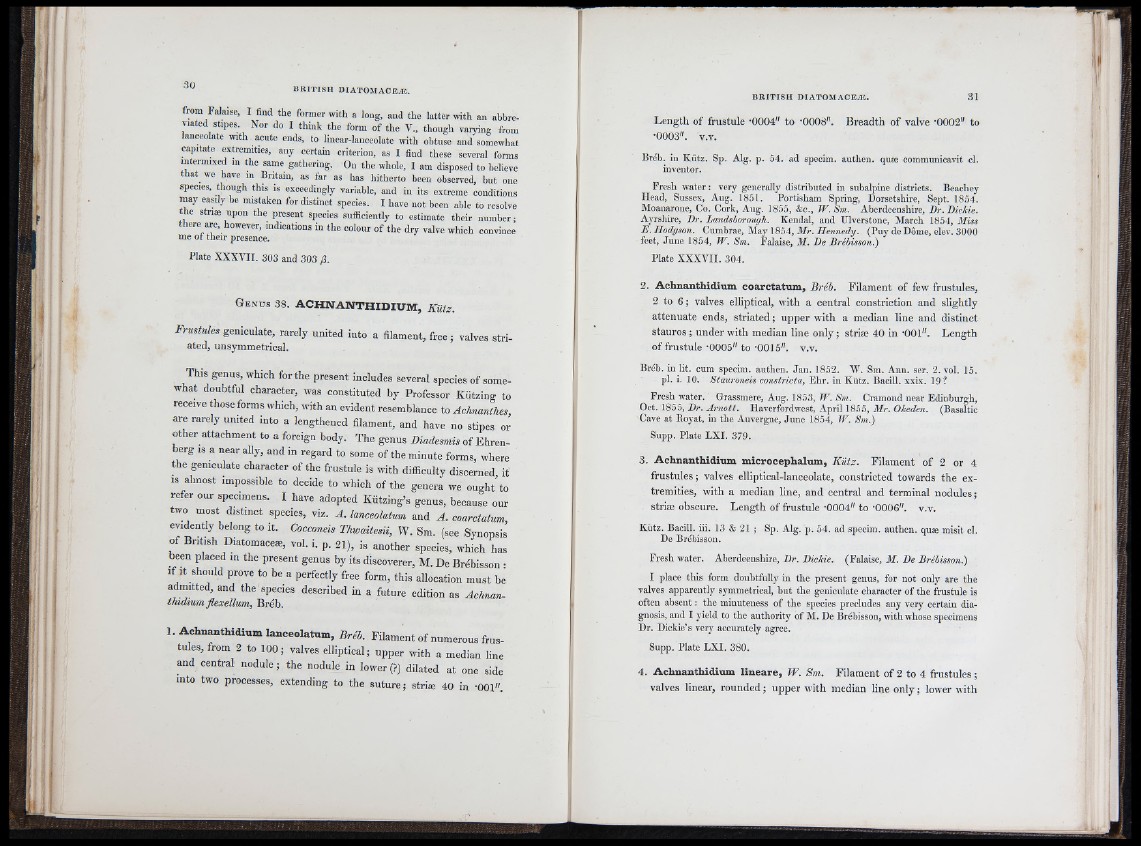
from Falaise. I find the former with a long, and the latter with an abbreviated
stipes. Nor do I think the form of the V„ though varying from
lanceolate witli acute ends, to linear-lanceolate with obtuse and somewliat
capitate extremities, any certain criterion, as I find these several forms
intermixed in the same gathering. On the whole, I am disposed to believe
that we have m Britain, as far as has hitherto been observed, but one
species, though this is exceedingly variable, and in its extreme conditions
may easily be mistaken for distinct species. I have not been able to resolve
the striæ upon the present species sufficiently to estimate their number;
there are, however, indications in the colour of the dry valve which convince
me of their presence.
Plate XXXVII. 303 and 303 ft.
G e n u s 38. A CH N AW TH ID IUM , Kütz.
Frustules geniculate, rarely united into a filament, free; valves striated,
unsymmetrical.
This genus, which for the present includes several species of somewhat
doubtful character, was constituted by Professor Kützing to
receive those forms which, with an evident resemblance to Achnanthes,
are rarely united into a lengthened filament, and have no stipes or
other attachment to a foreign body. The genus Diadesmis of Ehrenberg
IS a near ally, and in regard to some of the minute forms, where
the geniculate character of the frustule is with difficulty discerned it
IS almost impossible to decide to which of the genera we ought’to
refer our specimens. I have adopted Kützing’s genus, because our
two most distinct species, viz. A . lanceolatum and A . coarctatum,
evidently belong to it. Cocconeis Thwaitesii, W. Sm. (see Synopsis
of British Diatomaceæ, vol. i. p. 21), is another species, wffiich has
been placed in the present genus by its discoverer, M. De Brébisson •
If I t should prove to be a perfectly free form, this allocation must be
admitted, and the species described in a future edition as Achnan-
thidium flexellum, Bréb.
1. A ch n ^ th id ium lanceolatum, Bréb. Filament of numerous frustules,
from 2 to 1 0 0 ; valves elliptical; upper with a median line
and central nodule ; the nodule in lower (?) dilated at one side
into two processes, extending to the suture; striæ 40 in -001"
Length of frustule -0004" to -0008". Breadth of valve -0002" to
•0003". v.v.
Bréb. in Kiitz. Sp. Alg. p. 54. ad specim. authen. quæ communicavit cl.
inventor.
Fresb water: very generally distributed in subalpine districts. Beachey
Head, Sussex, Aug. 1851. Portisham Spring, Dorsetshire, Sept. 1854.
Moanarone, Co. Cork, Aug. 1855, &c., W.Sm. Aberdeenshire, Br. Diekie.
Ayrshire, Br. Landsborough. Kendal, and Ulverstone, March 1854, Miss
E. Hodgson. Cumbrae, May 1854, Mr. Hennedy. (Puy de Dôme, elev. 3000
feet, June 1854, W. Sm. Falaise, M. Be Brébisson.)
Plate XXXVII. 304.
2 . Achnanthidium coarctatum, Bréb. Filament of few frustules,
2 to 6 ; valves elliptical, with a central constriction and slightly
attenuate ends, striated ; upper with a median line and distinct
stauros; under with median line only; striæ 40 in -OOl". Length
of frustule -0005" to -OOi 5". v.v.
Bréb. in lit. cum specim. authen. Jan, 1852. W. Sm. Ann. ser. 2. vol. 15.
pi. i. 10. Stauroneis constricta, Ehr. in Kiitz. Bacill. xxix. 19?
Fresh water. Grassmere, Aug. 1853, W. Sm. Cramond near Edinburgh,
Oct. 1855, Br. Arnott. Haverfordwest, April 1855, Mr. Okeden. (Basaltic
Cave at Royat, in the Auvergne, June 1854, W. Sm.)
Supp. Plate LXI. 379.
3. Achuauthidium microcephalum, Kiitz. Filament of 2 or 4
frustules; valves elliptical-lanceolate, constricted towards the extremities,
with a median line, and central and terminal nodules;
striæ obscure. Length of frustule -0004" to -0006". v.v.
Kiitz. Bacill. iii. 13 & 21 ; Sp. Alg. p. 54. ad specim. authen. quæ misit cl.
De Brébisson.
Fresh water. Aberdeenshire, Dr. Dickie. (Falaise, M. De Brébisson.)
I place this form doubtfully in the present genus, for not only are the
valves apparently symmetrical, but the geniculate character of the frustule is
often absent ; the minuteness of the species precludes any very certain diagnosis,
and I yield to the authority of M. De Brébisson, with whose specimens
Dr. Dickie’s very accurately agree.
Supp. Plate LXI. 380.
4. Achnanthidium lineare, W. Sm. Filament of 2 to 4 frustules ;
valves linear, rounded; upper with median line only; lower with